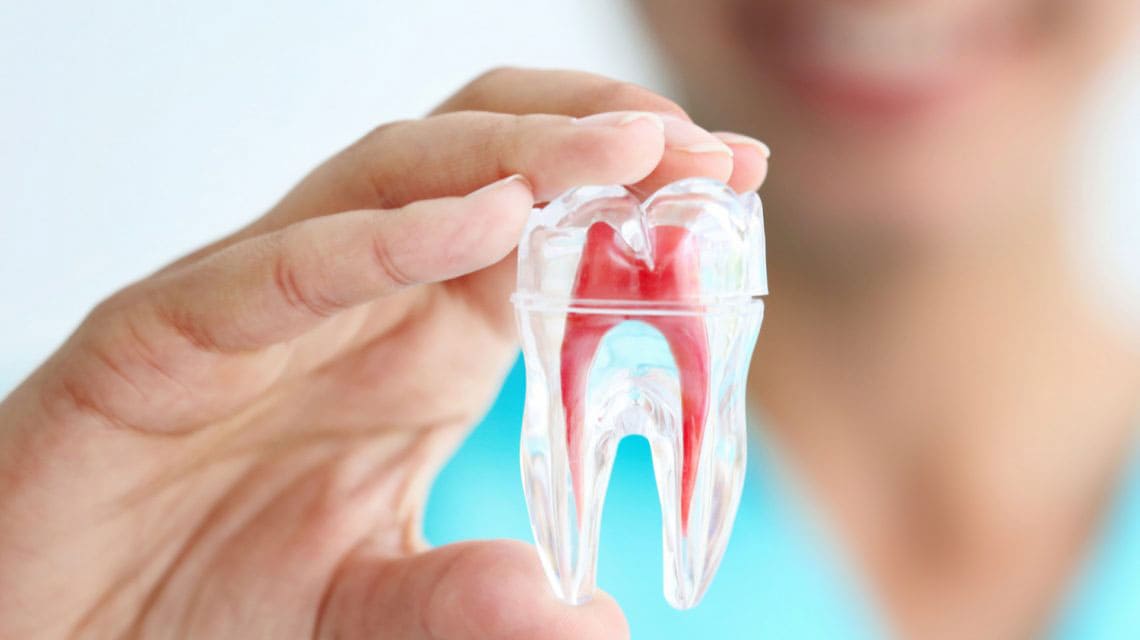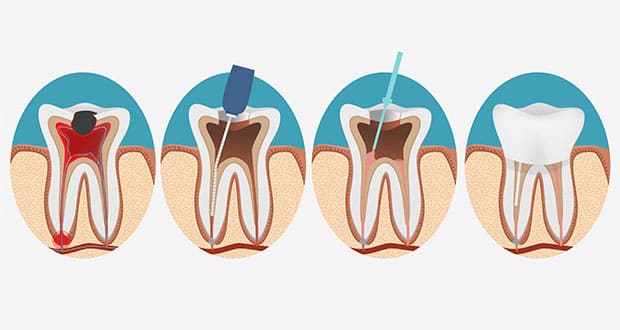What is Root Canal Pain?
07
July
2021

A root canal is a dental procedure that removes the decay inside the root of the tooth. The tooth is made out of an external layer called the enamel layer, a second layer, and an inside layer called core that extends and reaches the tooth’s root in the jawline area.
When decay gets into this softcore, it leads to an infection that could either be healed or that leads to the death of the root. This is where a root canal is needed in order to clean out the decay.
The pain that is related to the root canal could be the result of two different signs. It could be a symptom that lets the person know they need this dental procedure, or it could be an after effect of the procedure. But in both ways, the pain is temporary.
Therefore, if it lasts for more than three days, a doctor’s check-up might be recommended to rule out all other more dangerous possible reasons.
What are root canal pain symptoms?
The main symptom of root canal as we mentioned is persistent pain. Tooth pain could be the result of other problems such as gum disease, cavity, sinus infection, or a damaged filling. Therefore, the only way to be sure of it is by paying a visit to the dentist as soon as possible so they determine the main reason behind the pain and give the treatment accordingly.
The pain felt before the root canal procedure could be consistent at all times or might go away from time to time, then later come back. It is mostly felt deep in the bone of the tooth, but could also be rarely felt in the face, the jaw or in other teeth.
Some other symptoms include:
The swelling of the gums.
Sensitivity to hot and cold temperatures.
Pain while eating and chewing.
Putting any kind of pressure on the tooth.
Darkening color of the tooth.
A recurring pimple on the gums.
Sometimes no symptoms may show, which is why it is advised to always do a dental checkup to prevent any further damages.
What to expect after root canal surgery?
Root canal treatments will eventually heal the pain and all the symptoms felt before, but the procedure takes time. Until the permanent filling is in place, the healing process should be taken seriously. For example, it is forbidden to chew on the tooth while it is still under repair.
The couple of days following the procedure are crucial because the tooth will be very sensitive and in need of extra care and medications. Later on, everything will probably go back to normal; if not, scheduling a dentist appointment for another checkup is highly needed.
According to North Shore & Brookline Endodontics, “Root canal therapy is generally safe and effective, with a success rate of more than 95%.” (Nsbendo.com). It could be easily done another time, if the first procedure fails. And finally, it is important to note that the teeth which are fixed with root canal therapy last a lifetime.

What type of pain is felt after performing a root canal procedure?
After a root canal procedure, the feeling of pain and discomfort is normal for a short amount of time. But if the feeling lasts for a long time or becomes excessive, it is definitely a cause for attention.
Especially nowadays, with the help of modern medicine and anesthetics, this procedure has practically become as painless as a typical dental filling. With a reminder that if a root canal fails, redoing it can fix the problem easily and you shouldn’t worry about it.
-
How much pain is normal?
As previously mentioned, a little feeling of sensitivity, tenderness, and discomfort after having a root canal is normal, but it should go away within a few days. If the feeling does not decrease, the pain becomes more severe, and is unrelieved by the dentist’s tips, an evaluation is needed to see what the underlying problem is.
-
What are the causes of pain after a root canal?
-
Infection in the bone:
Even though the root canal procedure cleans out all the infections in the filling of the tooth, however, bacteria could still be circulating in the bone around the root. This leads to inflammation and a sensation of pain. Luckily, since the main source of the infection was removed during the root canal procedure, then the immune system will be able to wipe out the bacteria in no time. Antibiotics could help speed up the process.
-
Infected root canal:
A tooth can still get infected even after having a root canal procedure. This occurs when the filling of the tooth leaks, which allows bacteria from food or from the saliva to enter the edge of the filling and infect it. This leads to pain that can usually be treated easily unless the root of the tooth cracks and the tooth breaks below the gum line which can only be solved by tooth extraction.
-
Cement or air forced through the root tip:
When overfilling a root canal with dental cement, it leads to the emission of some of the material from the root tip. If the root tip was infected before the procedure, the emission could have no effect since there will be room for extra cement. But if the root tip was not infected, overfilling will lead to pain after the root canal. To add, pain is also dependent on the type of filling material used and on how much escaped.
Even though it is rare, there is a chance that a tiny bubble of air comes out of the root tip. This leads to pressure and pain.
In both cases, the pain should not be severe and will go away on its own.
-
Oversized filling:
If the final filling, also called the crown, is oversized, even if just a fraction too big, it will hit the opposite tooth with too much force that will eventually lead to pain. The dentist can easily replace the filling by another one with better size but the pain might linger for three to five days.
-
Sodium hypochlorite leak:
Sodium hypochlorite is a solution used by the dentist during a root canal to wash the tooth roots and kill all the bacteria. It dissolves and washes all the nerve tissue, but in some cases, the solution might leak out of the root tip causing immediate pain to the patient even if he is still numb. Taking antibiotics and painkillers for a couple of days after the root canal is the only way to get rid of the pain.
-
Missed canal:
Every person has a different amount of canals. Some people have more than others and sometimes the dentist might overlook an infected canal especially if he is a general dentist and not an endodontist. Leaving this untreated canal leaves room for bacteria to form more infections which leads to pain and the tooth will remain sensitive to hot and cold as it was before the root canal procedure, which is why it is better to go see a professional.
-
Instrument damage:
If the instrument used to achieve the procedure damaged the sensitive area that surrounds the tissue, it might lead to pain.
-
High temporary filling:
High temporary fillings suffer from the same issue as oversized fillings. In this case, the dentist puts a temporary filling that is not smooth enough and is a little higher than the surrounding tooth. It makes biting and eating harder and leads to sore teeth.
-
How to manage root canal pain at home?
After a root canal procedure, the dentist will prescribe pain relievers or other medications that should be sufficient to relieve the patient from the pain.
To add, avoiding biting and chewing on the affected tooth is very important until it is fully healed since the temporary filling is very delicate and easily breakable.
Finally, practicing good oral hygiene and brushing and flossing on a regular basis might help the recovery process.
How to prevent root canal pain?
Any tooth pain should be addressed with a dentist, but many tips can prevent pain, especially from root canal, that are beyond taking medications temporarily. These tips vary from taking care of your teeth on a daily basis even when no pain is felt, to avoiding hard and crunchy foods especially when you start feeling pain.
Other activities that might help are stress-relieving activities like meditation, yoga and tai chi that can take the focus off of the pain and let the person relax. Finally, quitting smoking has proven to help with relieving a person from any dental pain.
What are the root canal pain treatments?
As already mentioned previously, the only treatment for any kind of dental pain is a professional’s checkup and diagnosis, which is why no pain should be left unwatched and the sooner the treatment the better. In this case, some prevention might help ease the pain but eventually the root canal procedure is the only way to fully heal.
If you or anyone you know is suffering from root canal pain, call us today on (469) 562 4188 to book an appointment with our expert doctors.